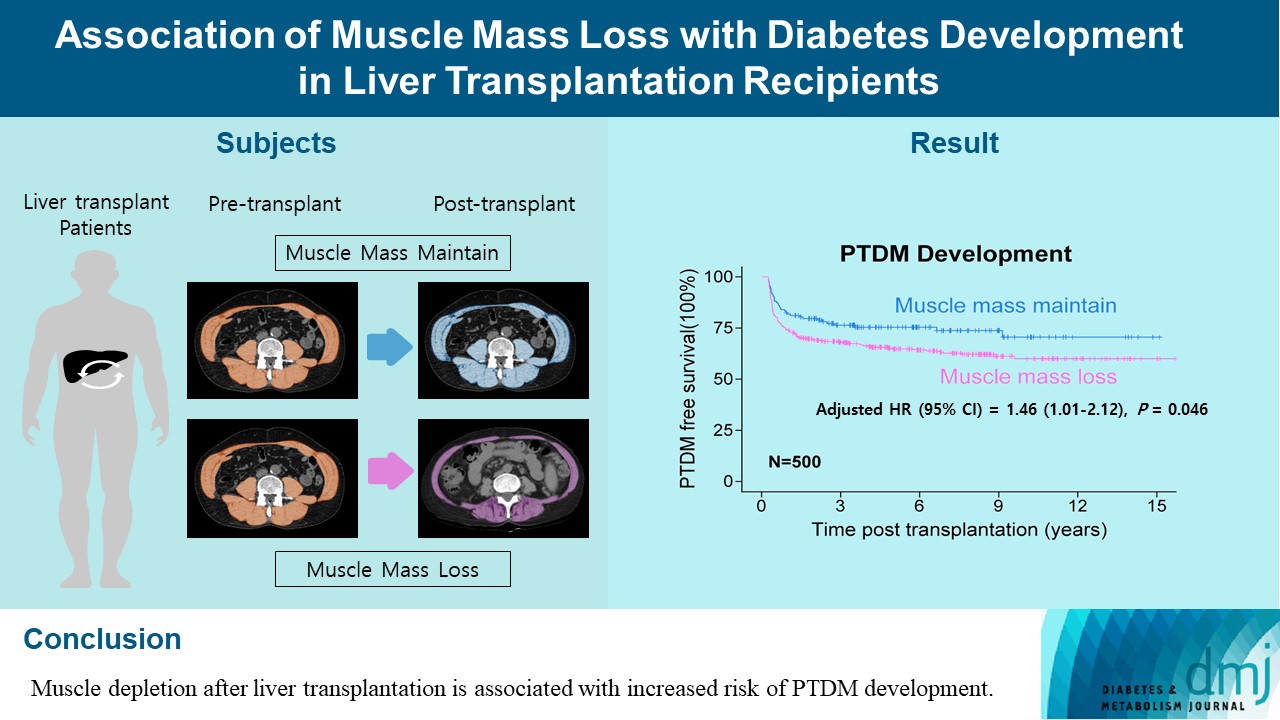
- Current
- Browse
- Collections
-
For contributors
- For Authors
- Instructions to authors
- Article processing charge
- e-submission
- For Reviewers
- Instructions for reviewers
- How to become a reviewer
- Best reviewers
- For Readers
- Readership
- Subscription
- Permission guidelines
- About
- Editorial policy
Search
- Page Path
- HOME > Search
Original Articles
- Complications
- Association of Muscle Mass Loss with Diabetes Development in Liver Transplantation Recipients
- Sejeong Lee, Minyoung Lee, Young-Eun Kim, Hae Kyung Kim, Sook Jung Lee, Jiwon Kim, Yurim Yang, Chul Hoon Kim, Hyangkyu Lee, Dong Jin Joo, Myoung Soo Kim, Eun Seok Kang
- Diabetes Metab J. 2024;48(1):146-156. Published online January 3, 2024
- DOI: https://doi.org/10.4093/dmj.2022.0100

- 1,028 View
- 122 Download
-
 Abstract
Abstract
 PDF
PDF Supplementary Material
Supplementary Material PubReader
PubReader  ePub
ePub - Background
Post-transplant diabetes mellitus (PTDM) is one of the most significant complications after transplantation. Patients with end-stage liver diseases requiring transplantation are prone to sarcopenia, but the association between sarcopenia and PTDM remains to be elucidated. We aimed to investigate the effect of postoperative muscle mass loss on PTDM development.
Methods
A total of 500 patients who underwent liver transplantation at a tertiary care hospital between 2005 and 2020 were included. Skeletal muscle area at the level of the L3–L5 vertebrae was measured using computed tomography scans performed before and 1 year after the transplantation. The associations between the change in the muscle area after the transplantation and the incidence of PTDM was investigated using a Cox proportional hazard model.
Results
During the follow-up period (median, 4.9 years), PTDM occurred in 165 patients (33%). The muscle mass loss was greater in patients who developed PTDM than in those without PTDM. Muscle depletion significantly increased risk of developing PTDM after adjustment for other confounding factors (hazard ratio, 1.50; 95% confidence interval, 1.23 to 1.84; P=0.001). Of the 357 subjects who had muscle mass loss, 124 (34.7%) developed PTDM, whereas of the 143 patients in the muscle mass maintenance group, 41 (28.7%) developed PTDM. The cumulative incidence of PTDM was significantly higher in patients with muscle loss than in patients without muscle loss (P=0.034).
Conclusion
Muscle depletion after liver transplantation is associated with increased risk of PTDM development.
- Protective Effects of Lithospermic Acid B on Diabetic Nephropathy in OLETF Rats Comparing with Amlodipine and Losartan.
- Eun Seok Kang, Beom Seok Kim, Chul Hoon Kim, Gi Ho Seo, Seung Jin Han, Sung Wan Chun, Kyu Yeon Hur, Chul Woo Ahn, Hunjoo Ha, Mankil Jung, Bong Soo Cha, Hyun Chul Lee
- Korean Diabetes J. 2008;32(1):10-20. Published online February 1, 2008
- DOI: https://doi.org/10.4093/kdj.2008.32.1.10
- 2,411 View
- 19 Download
- 1 Crossref
-
 Abstract
Abstract
 PDF
PDF - BACKGROUND
Lithospermic acid B (LAB), an active component isolated from Salvia miltiorrhizae, has been reported to have renoprotective effects in type 1 and type 2 diabetic animal models. We examined the effects of LAB on the prevention of diabetic nephropathy compared with amlodipine, a calcium channel blocker, and losartan, an angiotensin receptor blocker, in Otsuka Long-Evans-Tokushima Fatty (OLETF) rats, an animal model of type 2 diabetes. METHODS: LAB (20 mg/kg), amlodipine (10 mg/kg), or losartan (10 mg/kg) was given orally once daily to 10-week-old male OLETF rats for 28 weeks. RESULTS: None of LAB, losartan, and amlodipine exhibited effects on blood glucose levels. Treatment with amlodipine or losartan resulted in similar reductions in blood pressure; however, LAB was less effective in lowering blood pressure. Albuminuria was markedly suppressed by losartan and LAB, but not by amlodipine. LAB treatment decreased levels of renal lipid peroxidation, monocyte chemoattractant protein-1 (MCP-1), and transforming growth factor-beta1 (TGF-beta1). CONCLUSION: These results suggest that LAB has beneficial effects on the diabetic nephropathy in OLETF rats by decreasing oxidative stress and inflammation as potent as losartan. -
Citations
Citations to this article as recorded by- An Overview on Naturally Occurring Phytoconstituent: Lithospermic Acid
Bhupesh Chander Semwal, Amjad Hussain, Sonia Singh
The Natural Products Journal.2024;[Epub] CrossRef
- An Overview on Naturally Occurring Phytoconstituent: Lithospermic Acid

 KDA
KDA
 First
First Prev
Prev





